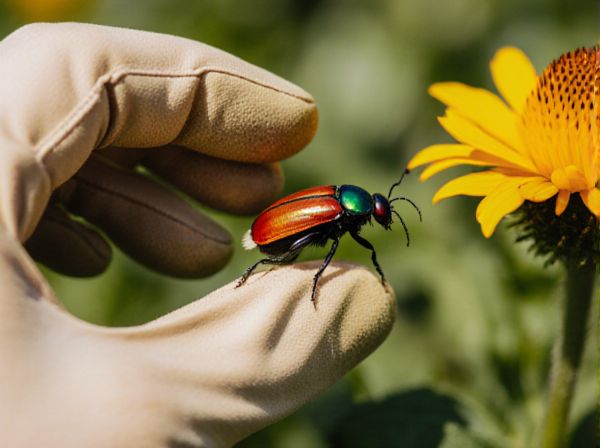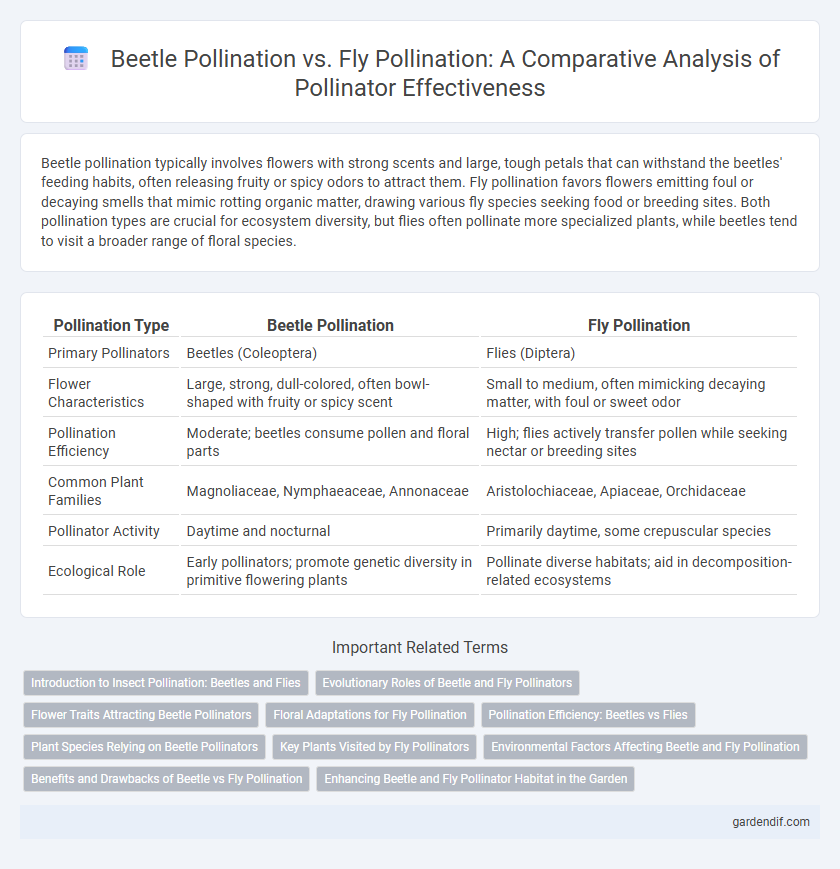
Beetle pollination vs Fly pollination Illustration
Beetle pollination typically involves flowers with strong scents and large, tough petals that can withstand the beetles' feeding habits, often releasing fruity or spicy odors to attract them. Fly pollination favors flowers emitting foul or decaying smells that mimic rotting organic matter, drawing various fly species seeking food or breeding sites. Both pollination types are crucial for ecosystem diversity, but flies often pollinate more specialized plants, while beetles tend to visit a broader range of floral species.
Table of Comparison
| Pollination Type | Beetle Pollination | Fly Pollination |
|---|---|---|
| Primary Pollinators | Beetles (Coleoptera) | Flies (Diptera) |
| Flower Characteristics | Large, strong, dull-colored, often bowl-shaped with fruity or spicy scent | Small to medium, often mimicking decaying matter, with foul or sweet odor |
| Pollination Efficiency | Moderate; beetles consume pollen and floral parts | High; flies actively transfer pollen while seeking nectar or breeding sites |
| Common Plant Families | Magnoliaceae, Nymphaeaceae, Annonaceae | Aristolochiaceae, Apiaceae, Orchidaceae |
| Pollinator Activity | Daytime and nocturnal | Primarily daytime, some crepuscular species |
| Ecological Role | Early pollinators; promote genetic diversity in primitive flowering plants | Pollinate diverse habitats; aid in decomposition-related ecosystems |
Introduction to Insect Pollination: Beetles and Flies
Beetle pollination, also known as cantharophily, involves beetles attracted to large, dull-colored flowers with strong odors, often emitting fruity or spicy scents to guide them. Fly pollination, or myophily, commonly occurs in flowers mimicking decaying organic matter, emitting foul or sweet smells that entice various fly species seeking nectar or breeding sites. Both beetles and flies play essential roles in insect pollination by transferring pollen while foraging, contributing to the reproductive success of diverse plant species.
Evolutionary Roles of Beetle and Fly Pollinators
Beetle pollination represents one of the earliest evolutionary associations with flowering plants, as beetles were among the first pollinators during the Cretaceous period, facilitating the diversification of angiosperms with their robust, chewing mouthparts adapted to floral tissues. Fly pollination evolved later, with flies exploiting a variety of ecological niches, especially in cooler or shaded environments, using their proboscises to access nectar and pollen from specialized flowers often mimicking decay or fermentation odors. The distinct evolutionary roles of beetle and fly pollinators reflect their morphological adaptations and behavioral strategies, driving floral trait diversification and contributing to plant reproductive success across diverse ecosystems.
Flower Traits Attracting Beetle Pollinators
Beetle-pollinated flowers typically exhibit strong, fruity or spicy scents and large, bowl-shaped structures with tough petals to withstand beetle activity. These flowers often produce ample pollen and nectar arranged in accessible patterns to accommodate the crawling behavior of beetles. In contrast, fly-pollinated flowers usually feature mimicked odors of decay or fermenting substances and possess tubular shapes suited to the flight mechanics of flies.
Floral Adaptations for Fly Pollination
Floral adaptations for fly pollination often include strong, unpleasant odors mimicking decaying organic matter to attract carrion and dung flies. Flowers tend to have dull colors such as brown or purple, and may present open or bowl-shaped structures for easy access to flies' short mouthparts. In contrast, beetle-pollinated flowers typically exhibit robust, heavily scented blooms with thick petals to withstand beetle feeding and movement.
Pollination Efficiency: Beetles vs Flies
Beetle pollination often results in lower pollination efficiency compared to flies due to beetles' less specialized body structures and more generalized foraging behaviors. Flies, particularly hoverflies, exhibit higher pollination efficiency because of their ability to visit flowers more frequently and carry pollen more effectively on specialized hairs. Studies demonstrate that fly-pollinated plants typically achieve greater fertilization success and seed set relative to those pollinated primarily by beetles.
Plant Species Relying on Beetle Pollinators
Plant species such as magnolias, water lilies, and pawpaws heavily rely on beetle pollinators due to their attraction to strong scents and durable floral structures. Beetle pollination, also known as cantharophily, often involves flowers that produce large quantities of pollen and emit fruity or spicy odors to lure beetles. In contrast, fly pollination targets species like carrion flowers and some orchids, which mimic decaying organic matter to attract specific fly species.
Key Plants Visited by Fly Pollinators
Fly pollinators frequently visit key wetland and alpine plant species such as skunk cabbage (Symplocarpus foetidus) and mountain avens (Dryas octopetala), which rely on flies for effective pollen transfer. These plants have evolved specific floral traits like strong odors and open structures to attract fly species, enhancing pollination efficiency in cooler or shaded habitats. Beetle pollination, in contrast, targets robust flowers like magnolias and water lilies, where beetles consume pollen or petals, making fly pollinators essential for a distinct ecological niche involving less woody, nectar-rich plants.
Environmental Factors Affecting Beetle and Fly Pollination
Beetle pollination thrives in warm, humid environments where flowers emit strong, fruity, or spicy scents to attract beetles, often favoring thick, bowl-shaped flowers that provide shelter and abundant pollen. Fly pollination commonly occurs in cooler, shaded, and moist habitats, with flies attracted to odors ranging from sweet to foul, including decaying organic matter, and flowers that mimic these scents to lure them. Environmental factors such as temperature, humidity, floral morphology, and odor chemistry critically influence the effectiveness and prevalence of beetle versus fly pollination in diverse ecosystems.
Benefits and Drawbacks of Beetle vs Fly Pollination
Beetle pollination benefits include effective pollination of large, bowl-shaped flowers and the ability to transport pollen over long distances due to their robust size, but drawbacks involve less targeted pollen transfer and potential flower damage from their feeding habits. Fly pollination, particularly by hoverflies or carrion flies, offers advantages such as pollination of diverse flower types, including those emitting strong odors mimicking decaying matter, with higher precision in pollen transfer; however, flies generally carry less pollen and have shorter foraging distances compared to beetles. Both pollinators contribute uniquely to ecosystem diversity, yet their effectiveness varies depending on floral morphology, habitat, and pollinator behavior.
Enhancing Beetle and Fly Pollinator Habitat in the Garden
Enhancing beetle and fly pollinator habitats in the garden involves planting a diverse range of native flowering plants that bloom at different times to provide continuous food sources. Beetles thrive in areas with decaying plant matter and mulch, so incorporating compost piles and leaving some leaf litter can attract them. Creating moist, shaded environments with shallow water sources supports fly populations, particularly hoverflies and bee flies, which are efficient pollinators for many garden plants.
Beetle pollination vs Fly pollination Infographic

 gardendif.com
gardendif.com